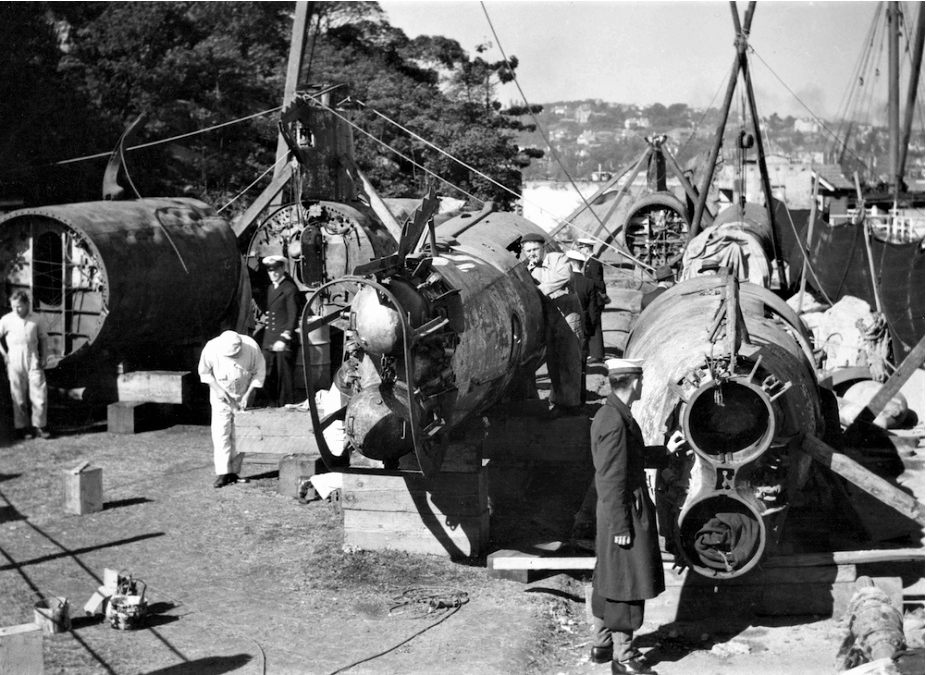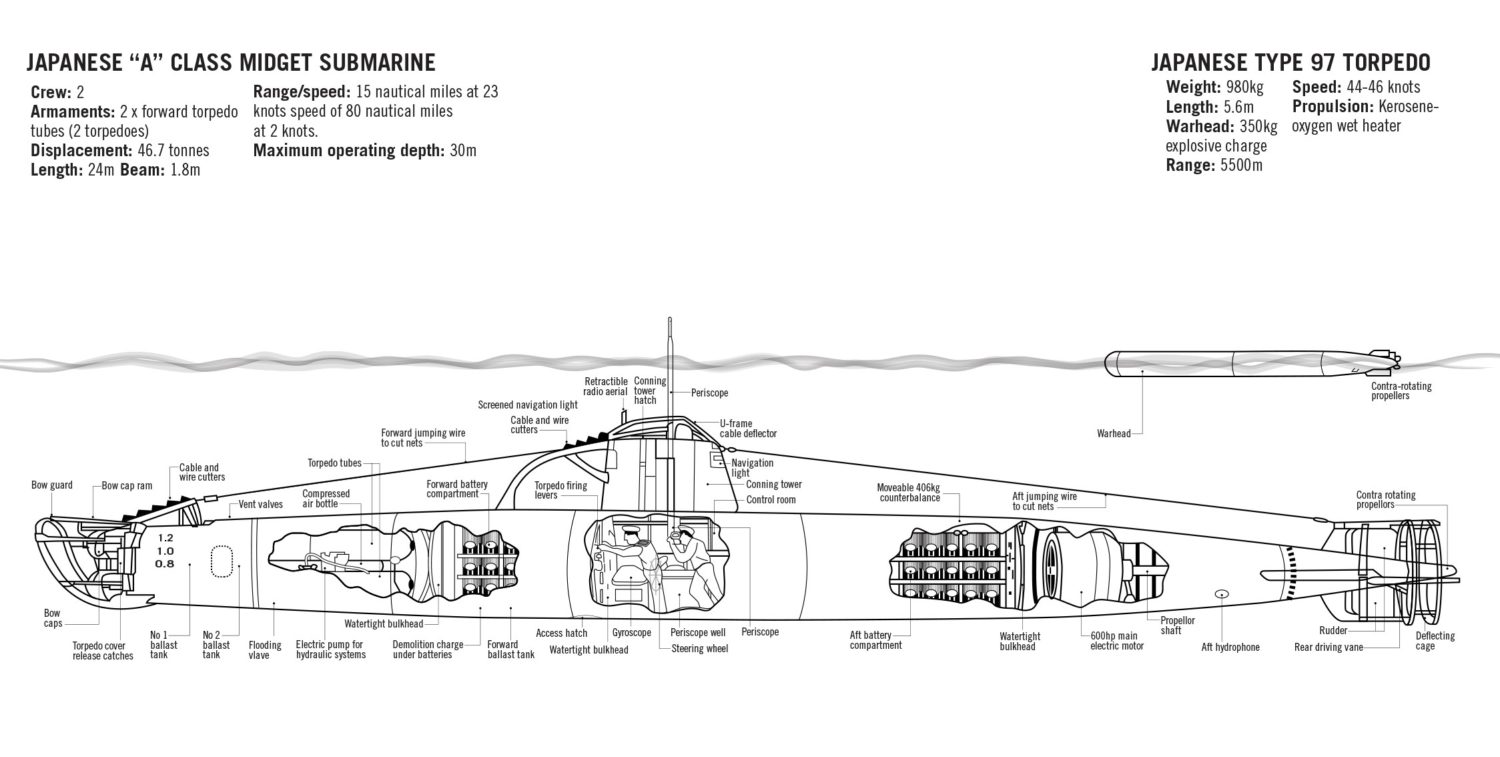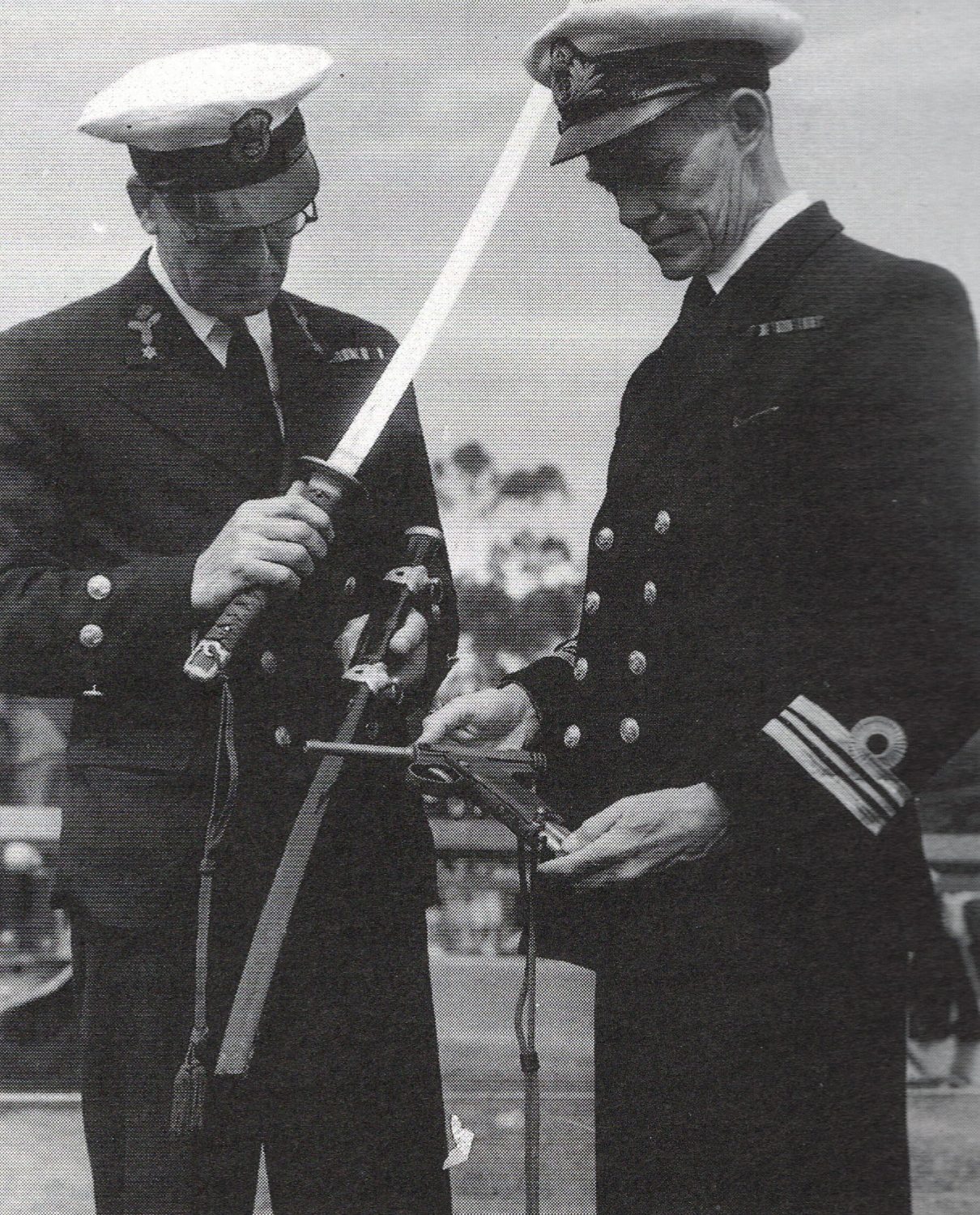The Mystery Sword of the Japanese Midget Submarine Raiders
A missing Japanese World War II sword from one of the midget submarines that attacked Sydney Harbour in 1942 may be somewhere concealed in an Australian home. Or is it the case that a sword which has been on display in the Australian war memorial for 80 years has been mis-labelled? In this extract from the new book Attack on Sydney Harbour (Big Sky Publishing) author Tom Lewis looks at the mystery.
-o-o-O-o-o-
On the Sunday night of 31 May 1942, Sydney Harbour was attacked by three midget submarines of the Imperial Japanese Navy. They had been launched by large fleet submarines from outside the port. In the raid, the accommodation vessel Kuttabul of the Royal Australian Navy was sunk by a torpedo impacting nearby, and 21 sailors died.
In a night of, chaos, indecision, incompetence, but much bravery, the midget submarines were counter-attacked. Two, commanded respectively by Lieutenants Chuma and Matsuo, were sunk, while another – Sub-Lieutenant Ban’s – was found outside the harbour in 2006. Chuma’s had become entangled in the protective boom net stretched party across the harbour main channel on the way in. When attacking vessels of the Navy were encountered, it was blown up and sunk by its own crew members. Matsuo’s was depth-charged several times by RAN small ships, and eventually it was cornered in Taylors Bay. Its crew shot themselves. Neither boat managed to fire its torpedoes against a target, due to the efforts of the small ships attacking them.
War had already come to northern Australia, and now the southern cities were to be made bitterly aware the world-wide conflict had reached them. The midget submarine attack was only the beginning: gun strikes were made against land targets, and more enemy submarines came south, attacking freighters up and down the continent’s eastern coast.
Realising this and seeing the midget submarines had been raised from the harbour floor, and were being examined, a decision was made to commence a land tour of southern states with a midget submarine on a truck. This, it was hoped, would raise money for military charities, encourage the purchase of war bonds, and raise awareness of the impacts of the war.

| Salvaged sections of M-22 and M-27 Midget Submarines on Clarke Island |
One curious effect of the tour was the subsequent distribution around the country of a myriad of souvenirs from the submarines. These included lead models, about 20 centimetres in length, made from the ballast of the two raised boats. Thousands were sold during the midget submarine tour. They may still be occasionally found on ebay.Other souvenirs were taken informally from the wrecks.
Perhaps the most important – and certainly the most iconic relic, was a sword taken into the battle by one of the commanders of the two-man midget vessels. Taking such a weapon along on a combat mission was not unusual for Japanese officers. Not only did it show patriotism, but also their determination to fight to the end.
Of course, Japanese Army soldiers were indeed carrying swords in battle: thousands were encountered; occasionally captured; sometimes copied for souvenir-selling, and surrendered en masse at the end of the war. For members of aircrews and ships however, the weapon was more symbolic than useful. Some of this attitude was likely more for propaganda and psychological reasons. While fighter pilots have been occasionally photographed with swords it is unlikely, as military historian Michael Claringbould[1] has emphasised, that they took them into their cramped cockpits where they would have actually proved an impediment and is therefore highly unlikely.
Bombers, as Dr Peter Williams shows, may have been different though:
“As we lined up for our bombing run two British Hurricanes dived in among us from the cloud over my head. I saw their tracer bullets like a thin red line that went through between our bombers. Then I saw a big explosion in front of me. One of our bombers exploded, disappearing instantly. Seven men dead in a moment. The commander of the bomber was Staff Sergeant Furukoshi, who I used to fly paired with in China. He’d taught me a lot about bombing missions in those battles. Furukoshi was always carrying a Buddhist scripture and a sword while in the air, by way of being prepared for his death. I am sure that the way he died was something he had always wished for. I very much envied him for the way he died.” [2]
Naval personnel of course had more room for such items to be taken to war. For example, the first five vessel midget submarine attack in the Pearl Harbor raid saw one submarine crewman captured. On board his two-man submarine, washed up on a beach, was found his sword – it’s now in the US Naval Academy Museum at Annapolis. [3]

Some six months after Pearl Harbour it was Sydney’s turn. What may be the sword of Lieutenant Chuma of the Imperial Japanese Navy has been displayed in the Australian War Memorial for many decades. It is a traditional “samurai” sword, rather than the Western naval hilt model used in most navies, including Japan’s in WWII. This may be the sword shown in a photograph of two naval personnel, perhaps Chief Petty Officer Anderson of HMAS Lolita, one of the attacking RAN vessels, and an unidentified lieutenant commander, who are inspecting a sword and a pistol. The photograph was taken in the days following the attack, after the submarines had been craned out of the harbour; inspection and disassembly had begun; and the building into a recognisable composite model of one submarine had begun by engineering personnel tasked with readying a touring submarine.

The sword was officially offered to the AWM in July 1942 by the then-Prime Minister, John Curtin.[4] It would be presumed that the provenance of this weapon would have been done properly for the Prime Minister; ie: the sword was definitely traced back to the Chuma submarine recovered at the boom net. However, there are plenty of other sources that reference a sword being carried by Matsuo – eg: within the Taylors Bay submarine:
Lew Lind, a prolific author and historian, says he personally inspected, in late 1943, the items retrieved from the midgets, which included: “two pistols, a ceremonial sword believed to have been presented to Matsuo by his family, a German Leica camera and several embroidered scarves. These items have been presented to the Australian War Memorial in Canberra.”[5]
Lind is perhaps the source others have followed for the other mentions of the sword in this list. Many authors and historians have made comments on it, linking the sword with Matsuo but never Chuma. For example,
- Clarke says Matsuo took “a dagger” with him[6]
- Carruthers says that Matsuo took “a new ceremonial sword inscribed with his name” with him.[7]
- Warner and Seno say Matsuo’s sword[8] was wrapped in a “red brocade bag”
- Jenkins suggests Matsuo was armed with a “sword presented to him by his father, still wrapped in the red brocade bag made from his mother’s wedding dress”[9] (Earlier however he says Tsuzuku in the same boat carried “a ceremonial sword”)
- The film One Thousand Spears of the Kikuchi Clan, made in Japan, released in 1944, was centred around the sword Matsuo took with him on his final voyage. In the film Matsuo is presented with a sword by his father. [10] In a published essay, his brother wrote that “Matsuo had been presented with a Kikuchi sword by his father before the mission”.[11]
So the Chuma sword, on exhibition now, is an enigma. When originally recovered, it was taken apart, as documented in an AWM publication and in their online catalogue.[12] What is displayed now is a handle/hilt attached to a scabbard. Above that is a naked sword blade, with the tang (a continuation of the blade to go up inside the handle) matching the scabbard dimensions. If there are two blades there, with another in the scabbard, then we have two weapons. Or is the blade displayed apart, and therefore we have one? The signage is inconclusive – it suggests one sword. However, the AWM, in communication with the author, have said they only possess one, and it is Lieutenant Chuman’s [sic].[13]
Whether there were two swords within the midget submarines recovered from Sydney Harbour is uncertain. It is further of interest in that all of the suggestions of a sword are a) singular, and b) Matsuo’s. There does not seem to have ever been a source that says there were indeed two Japanese weapons found. Notably Lind, who actually inspected the items, as cited above, only mentions one.
Further, the possibility that the original gift from the PM to the AWM was a mix-up cannot be discounted. For a sword to be recovered from the Chuma submarine would be difficult. The demolition explosion smashed the boat open primarily at the mid-section where a sword would have been stored. The loose items within would have been scattered across a debris field on the seabed near the wreck, which by now was open to the sea. The divers in 1942 were tasked with recovering the wreck of the midget, not gathering up loose items from the surrounding sand in cold and dim conditions. It would be more the case that the loose items were not recovered.
In summary, there does not seem to be any evidence Lieutenant Chuma took a sword with him in his last combat action. There seems to be alternative evidence that Matsuo did. The two strongest pieces for this conclusion are first that it was actually sighted and connected to his submarine by someone there at the time – Lew Lind. Additionally, Matsuo’s family say he took a sword to sea with him.
The Chuma sword in the AWM therefore is actually likely to be the Matsuo sword. If this is not the case, and Chuma can be connected to the weapon, then it must be the case that Lind made a mistake, and the Matsuo family did too. Matsuo, it may then be surmised, did not take a sword to sea. If in fact he did, then somewhere in Australia the sword of Matsuo may be found. In these cases, the simplest answer is usually the one. I suggest in closing that the AWM sword has been mislabelled; that it came from the Taylor Bay submarine of Lieutenant Matsuo, rather than that of Lieutenant Chuma, and that only one sword was captured from the midget submarine attack of Sydney Harbour in 1942.

Japanese Imperial Navy, midget submarine crew members

Wreck of Japanese midget submarine M24, 5 kilometres east of Bungan Head, Sydney
-o-o-O-o-o-
Dr Tom Lewis OAM is a military historian, and retired naval officer. He is also the author of Eagles over Darwin: how the USAAF flew the sole air defence for northern Australia for much of 1942; Atomic Salvation, how the A-Bombs saved the lives of 30 million people; and Teddy Sheean VC, which recently won the Commodore Sam Bateman Book Prize from the Australian Naval Institute.
[1] Conversations with Michael Claringbould, author of such works as Pacific Profiles. IJN Floatplanes 1942-1944 South Pacific. Avonmore, 2022.
[2] Williams, Dr Peter. Japan’s Pacific War: Personal Accounts of the Emperor’s Warriors. Pen and Sword: Barnesley, 2021. (p. 6)
[3] Fuller, Richard, and Ron Gregory. Japanese Military and Civil Swords and Dirks. Airlife: England, 1996. (p. 129)
[4] Australian War Memorial. Treasures from a Century of Collecting. Murdoch, 2021. (pp: 406-407)
[5] Lind, Lew. Toku-Tai. Japanese Submarine Operations in Australian Waters. Kangaroo Press, 1992. (p. 79) In another book – Lind, Lew. The midget submarine attack on Sydney. Bellrope Press, 1990, (p. 50) he says the sword was given to the AWM “after the war”.
Lind was awarded the British Empire Medal for his services to History. In his Obituary he was described as “Author, historian, curator, soldier, journalist, patriot, artist, friend, churchman, scholar, father, husband, community worker…” He was a founder and developer of the Naval Historical Society of Australia. Interestingly his quoted remark says “…in 1943” whereas the tour began in 1942. Anecdotally a sword was taken on the tour.
[6] Clarke, Hugh. Fire one! Angus and Robertson, 1978. (preface; no page numbers); p4.
[7] Carruthers, Steven L. Australia under siege: Japanese submarine raiders, 1942. Solus Books, 1982. (p. 116)
[8] Warner, Peggy, and Sadao Seno. The Coffin Boats. Leo Cooper, 1986. (p. 95)
[9] Jenkins, David. Battle Surface. Random House, 1992. (pp: 226-229). The reference to Tsuzuku is on p. 220.
[10] Tamura, Keiko. “Triumphant return in silence”. Wartime. Issue 45. January 2009. (pp: 46-49) Also see the discussion site Axis History Forum, and https://forum.axishistory.com/viewtopic.php?t=158685
[11] Tamura, Keiko. “Triumphant return in silence”. Wartime. Issue 45. January 2009. (p. 48) A caption on the next page under the photo of the RAN members holding the sword and pistol identifies them as being from Chuman’s submarine, and then says “Matsuo’s sword, however, has vanished.”
[12] Australian War Memorial. Treasures from a Century of Collecting. Murdoch, 2021. (pp: 406-407) See also RELAWM30098.003 and RELAWM30098.001. “Japanese Katana Sword Blade: Lieutenant Kenshi Chuman, Midget submarine Ha-14 Imperial Japanese Navy.”https://www.awm.gov.au/collection/C209155?image=1 These appear to show the sword disassembled as a blade, and as the mountings and scabbard as per the in-house display.
[13] Email to the author from Mr Brian Dawson, Assistant Director National Collection, Australian War Memorial. 8 April 2022. Chuma is often referred to, as in this case, as “Chuman”.…the author’s sourcing of the spelling is from Japanese documents.




